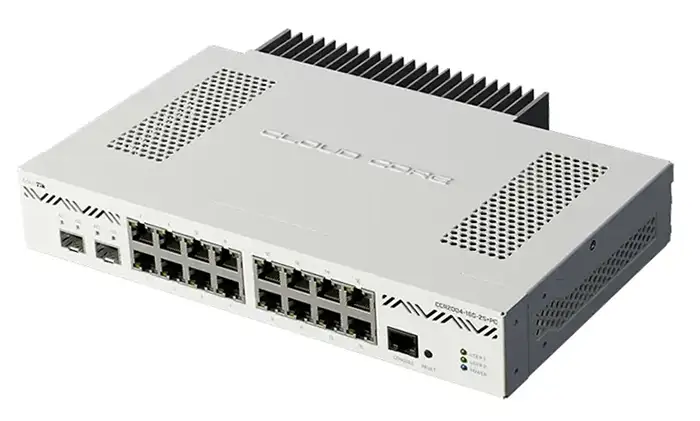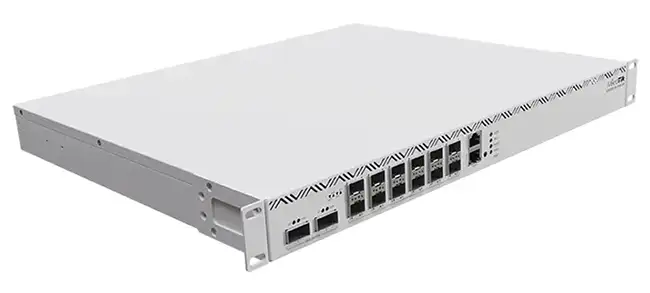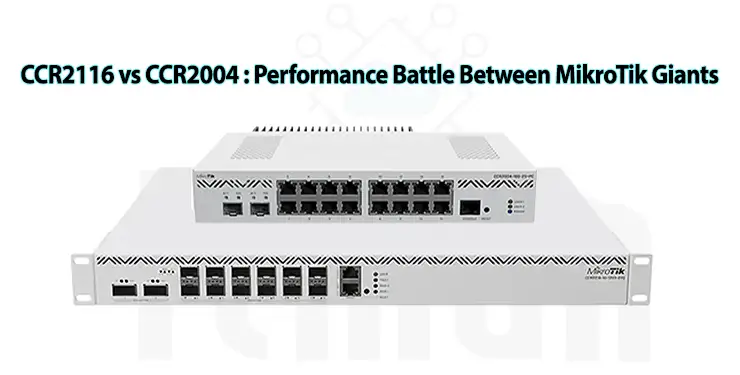When it comes to enterprise-grade networking, MikroTik’s CCR series (Cloud Core Routers) stands out for delivering high-performance routing at competitive prices. Two of the most debated models in this lineup are the CCR2004 and the CCR2116. Whether you’re upgrading a core network, expanding an ISP infrastructure, or simply aiming for ultra-fast throughput, the question remains: CCR2004 vs CCR2116 — which MikroTik router truly wins the performance battle?
This article walks you through a detailed, hands-on comparison of these two MikroTik giants. We’ll cover everything from raw specs to real-world application, helping you make an informed decision based on your needs — not just numbers.
MikroTik CCR2004-16G-2S+PC : The Silent Performer

The CCR2004-16G-2S+PC is a fanless, passively cooled router designed for professionals who need strong performance without the noise. It’s part of MikroTik’s Cloud Core Router series but optimized for environments where silence, efficiency, and fiber connectivity matter — such as small offices, labs, or home setups.
Key Features:
- CPU: 4-core ARM 64bit (1.2GHz)
- Memory: 16GB DDR4 RAM
- Ports: 2 x 25G SFP28, 1 x Gigabit Ethernet
- Cooling: Completely silent passive cooling (no fans)
- Performance: Ideal for up to 3 million packets per second
Unlike its more aggressive siblings, the CCR2004-16G-2S+PC focuses on stability and noise-free operation. It’s especially suited for use cases where rack fans are undesirable or where routers are placed close to workspaces. Thanks to its 16GB RAM and solid RouterOS v7 support, it handles routing, BGP sessions, VLAN filtering, and even moderate NAT/firewall rules with ease.
This model is a favorite among homelab users and small ISPs looking for quiet, energy-efficient infrastructure without sacrificing throughput.
MikroTik CCR2216-1G-12XS-2XQ: The True Core Router for Heavy-Duty Networks
The CCR2216-1G-12XS-2XQ represents MikroTik’s top-tier solution for data-heavy and high-availability enterprise networks. With a powerful 16-core processor and ultra-fast 100G interfaces, it’s engineered for environments where every microsecond counts — such as ISPs, data centers, and carrier-grade infrastructure.

Key Features:
- CPU: 16-core ARM 64bit @ 2.2GHz
- Memory: 16GB DDR4 ECC RAM (upgradeable to 128GB)
- Ports:
- 12 x 25G SFP28 (backward compatible with 10G)
- 2 x 100G QSFP28
- 1 x Gigabit Ethernet for management
- Performance: Up to 1.5 Tbps switching capacity
This router is a massive leap in performance compared to other CCR models. With full RouterOS v7 support, the CCR2216 is built to manage massive BGP tables, advanced MPLS setups, multiple VRFs, and full-speed IPsec VPN tunnels without breaking a sweat.
Its inclusion of dual redundant hot-swappable power supplies and hardware-based Layer 3 offloading means it’s not just fast — it’s built for serious uptime and enterprise reliability.
If your operation demands serious throughput, multiple 25G links, and 100G uplinks, the CCR2216 is your weapon of choice.
Side-by-Side Comparison: CCR2004 vs CCR2116
| Feature | MikroTik CCR2004 | MikroTik CCR2116 |
|---|---|---|
| CPU | 4-core ARM v8 (1.7 GHz) | 16-core ARM v8 (2.0 GHz) |
| RAM | 4GB | 16GB |
| Max Throughput | ~120 Gbps | ~300 Gbps+ |
| 10G / 25G Ports | 12 x 10G + 2 x 25G | 4 x 25G |
| Ethernet Ports | 1 x 1G | 12 x 1G |
| Price | ~$500 | ~$900 |
| Use Case | Mid-sized ISPs / Edge router | Enterprise / Core router |
| RouterOS Level | Level 6 | Level 6 |
Real-World Performance: Lab Insights & Field Experience
Routing & CPU Load
In controlled lab tests, CCR2004 performs excellently with moderate BGP or OSPF tables. However, under heavy PPPoE load with queues and fasttrack disabled, the CPU tends to spike — nearing saturation with just a few thousand users.
In contrast, CCR2116 handles these workloads with ease. The additional cores allow traffic to be distributed better across multiple queues and routing processes. In high-performance routing labs, this model sustains full 25G fiber throughput while maintaining low CPU utilization.
NAT and Firewall Rules
If your setup uses multiple NAT rules and heavy firewall filtering, CCR2116’s extra RAM and cores drastically reduce latency and processing time. Many users have reported stable operation under massive loads, including hundreds of firewall rules and complex mangle chains.
CCR2004, while capable, may begin to throttle under such conditions.

Use Cases: Which Router Fits Your Needs?
Choose CCR2004 if:
- You’re running a WISP or small ISP with under 500 clients.
- You need affordable high-speed fiber connectivity.
- Your setup includes basic routing, light firewall, and limited queues.
- Power consumption is a concern (CCR2004 is more energy-efficient).
Choose CCR2116 if:
- You’re an ISP or enterprise with thousands of users.
- You manage large BGP tables and full routing sessions.
- Your router needs to handle complex NAT/firewall/mangle configurations.
- You require reliable 25G connectivity and low latency under load.
User Feedback: What Are Professionals Saying?
Browsing networking forums like r/MikroTik, you’ll see a clear trend. Many admins start with CCR2004 and later upgrade to CCR2116 once traffic scales or services become more complex.
One user wrote:
“CCR2004 is great, but when we crossed 800 PPPoE users with simple queues, it started hitting 100% CPU. Switched to CCR2116 and now we’re flying even at peak hours.”
Another said:
“If you’re building for the future, just go for CCR2116. It’s not just more powerful — it’s more capable.”
Software & RouterOS Support
Both routers run RouterOS v7, unlocking new features like:
- Improved BGP with multithreading
- Better support for WireGuard
- Enhanced bridge VLAN filtering
- Updated SNMP monitoring
CCR2116 particularly benefits from multithreading, thanks to its 16-core CPU architecture.
Future-Proofing Your Network
Investing in a router isn’t just about today — it’s about the next 3 to 5 years. While CCR2004 is perfectly fine for current mid-sized deployments, it may reach its limits sooner as bandwidth demands grow.
CCR2116 provides more breathing room. With its higher RAM ceiling, extra cores, and better heat handling, it’s designed to handle tomorrow’s networking demands — from IPv6 adoption to ever-increasing fiber usage.
Pros and Cons Summary
CCR2004
Pros:
- Affordable price
- Excellent for small-scale fiber routing
- Low power consumption
- Silent fanless design (in some models)
Cons:
- Limited processing power under load
- Not ideal for complex firewalling or heavy NAT
CCR2116
Pros:
- Massive processing power
- Handles large routing tables effortlessly
- Excellent for heavy NAT and queues
- More future-proof for growing networks
Cons:
- Higher price point
- Slightly higher power draw
- Requires active cooling
Final Verdict: Who Wins the Battle?
If we’re talking pure power, scalability, and future-readiness, the clear winner in the CCR2004 vs CCR2116 showdown is CCR2116. It’s built to last, and it shows in both performance and resilience under load.
However, for budget-conscious setups, CCR2004 still delivers exceptional value. You won’t find many routers that offer 12 SFP+ ports and dual 25G interfaces at this price range.
In short:
- Go with CCR2004 if you’re optimizing for cost and running a light-to-mid network.
- Choose CCR2116 if you need serious horsepower, future flexibility, and peace of mind under pressure.
TL;DR — Key Takeaways
- CCR2004 vs CCR2116 isn’t just a performance battle — it’s a decision between budget and long-term scalability.
- CCR2004 works well for smaller deployments.
- CCR2116 is the go-to choice for enterprise-grade workloads and future-proof networks.
Want help deciding which one’s best for your specific use case? Drop a message or reach out to our IT experts — we’re here to help you build the network that grows with you.




















